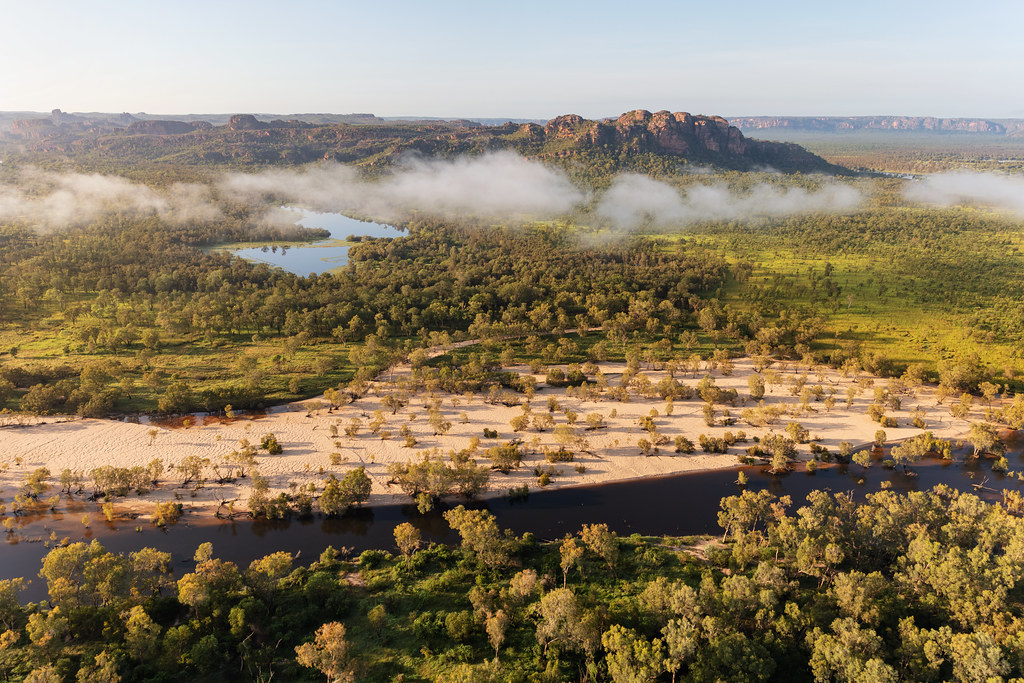#darwin to jabiru
Explore tagged Tumblr posts
Text
The Timeless Beauty of Katherine Gorge: A Must-See Destination in the Northern Territory
Introduction
Nestled in the heart of Australia's rugged Northern Territory, Katherine Gorge is a breathtaking natural wonder that draws visitors from around the world. Located within Nitmiluk National Park, this iconic landmark is a testament to the timeless beauty of the Australian Outback. With its towering sandstone cliffs, crystal-clear waters, and lush surrounds, Katherine Gorge offers a stunning landscape that is both serene and awe-inspiring.
But Katherine Gorge is more than just a picturesque destination—it’s a place steeped in rich cultural significance, home to the ancient Jawoyn people, whose connection to the land spans tens of thousands of years. Whether you're seeking adventure through kayaking and hiking or looking to explore the rich heritage and wildlife of the area, Katherine Gorge offers something for everyone. This article will take you on a journey through the gorge's natural wonders, cultural history, and the unforgettable experiences that make it a must-see destination in the Northern Territory.
Introduction: Discovering Katherine Gorge
Katherine Gorge, located within the stunning Nitmiluk National Park in the Northern Territory, is a true gem of Australia's outback. Known for its dramatic landscapes, towering sandstone cliffs, and crystal-clear waters, Katherine Gorge captivates visitors with its natural beauty and rich cultural history. The gorge, which stretches for 13 kilometers, is a series of spectacular gorges carved by the Katherine River, offering a diverse range of experiences for nature lovers, adventure seekers, and cultural enthusiasts alike.
This awe-inspiring destination is not just about striking scenery; it’s a place of profound cultural significance for the Jawoyn people, the traditional custodians of the land. With over 40,000 years of Aboriginal history, Katherine Gorge is deeply tied to the stories, legends, and traditions of the Jawoyn. The gorge’s cliffs and rock formations serve as a canvas for ancient rock art, telling the stories of the Dreamtime and providing insight into the region’s long history.
Visitors to Katherine Gorge are welcomed with a range of outdoor adventures, including kayaking along the tranquil river, hiking through rugged trails, and taking boat cruises to explore the picturesque gorges. Whether you’re looking for relaxation or seeking an adrenaline-fueled experience, Katherine Gorge offers something for everyone. With its untouched wilderness, abundant wildlife, and cultural depth, Katherine Gorge is truly a must-see destination that provides an unforgettable glimpse into the heart of Australia’s natural and cultural heritage.
A Geological Marvel: The Formation of Katherine Gorge
Katherine Gorge is a stunning testament to the power of nature, shaped over millions of years by geological forces that have carved out its dramatic landscapes. The gorge’s towering sandstone cliffs, narrow waterways, and striking rock formations tell the story of a deep and ancient history, offering visitors a glimpse into the earth's geological past.
The gorge was primarily formed through erosion and the gradual movement of the Katherine River. Over 20 million years ago, during the Tertiary period, the region was covered by ancient seas. As the seas receded, the area was left with layers of sedimentary rock, including sandstone, limestone, and shale. Over time, the Katherine River began to carve its path through these rock layers, creating a network of deep gorges, waterfalls, and ravines.
The river’s continuous flow, combined with the pressure of geological forces, has shaped the distinctive landscape of Katherine Gorge. The sandstone cliffs, which rise dramatically from the river, were once part of vast ancient mountains. These cliffs have withstood the test of time, with some reaching over 70 meters in height. As the river eroded the softer rock layers, it exposed the more resistant sandstone, creating the awe-inspiring cliffs that define the gorge today.
In addition to the gorge's rock formations, the region is home to karst landscapes, a type of landscape shaped by the dissolution of soluble rocks such as limestone. This geological feature is evident in the park's cave systems and limestone ridges, which have been carved by water over millennia. These features add to the beauty and complexity of the region, offering opportunities for exploration and discovery.
The formation of Katherine Gorge is not only a marvel of nature but also a reminder of the enduring forces that have shaped the Australian landscape. As you explore the gorge, it’s impossible not to be awed by the sheer scale and beauty of this geological wonder, a landscape that has been sculpted over millions of years and continues to captivate visitors today.
Cultural Heritage: The Aboriginal Connection to Katherine Gorge
Katherine Gorge holds profound cultural and spiritual significance for the Jawoyn people, the traditional custodians of the land. For thousands of years, the gorge has been an integral part of their way of life, shaping their stories, customs, and spiritual beliefs. The Jawoyn people’s connection to the land is deeply embedded in the region’s natural beauty, and their enduring bond with Katherine Gorge is reflected in the many sacred sites, rock art, and Dreamtime stories that are found throughout the area.
The Jawoyn have lived in the Katherine region for over 40,000 years, and their ancestors’ stories are closely tied to the landscape of Katherine Gorge. The river, cliffs, and surrounding bushlands are not only natural features but also living cultural landmarks, with each site carrying its own significance in the Jawoyn belief system. The gorge is seen as a place of spiritual power and a living reminder of the Dreamtime—the period in Aboriginal mythology when the world was created by ancestral beings. These beings are said to have created the landforms, waterways, and animals that the Jawoyn people still revere today.
One of the most striking aspects of Katherine Gorge is its rock art. These ancient paintings, which are found on the cliff faces and caves throughout the gorge, are a testament to the Jawoyn people's long history in the area. The rock art depicts scenes of animals, hunting, and rituals, as well as ancestral figures tied to the Dreamtime. These artworks serve as both a historical record and a spiritual connection, passing down knowledge from generation to generation. Many of the sites are considered sacred, and they hold special meaning for the Jawoyn people, who continue to care for and protect them.
In addition to the rock art, the Katherine River itself holds great spiritual importance for the Jawoyn. The river is seen as a lifeline, providing sustenance and a pathway for both travel and communication. It is deeply intertwined with the stories of creation and is still a source of cultural connection for the Jawoyn people, who continue to use the river for traditional purposes such as fishing, gathering food, and ceremonial practices.
Today, the Jawoyn people welcome visitors to Katherine Gorge and invite them to learn about the cultural significance of the area. Guided tours led by local Aboriginal guides offer invaluable insights into the traditional stories and customs of the Jawoyn, as well as the cultural landscapes that make Katherine Gorge such a special place. These tours provide a deeper understanding of how the Jawoyn people have lived in harmony with the land for millennia, and how their cultural heritage continues to shape the way they interact with the gorge today.
By respecting and engaging with the cultural heritage of Katherine Gorge, visitors can gain a richer, more meaningful experience of this extraordinary natural wonder. It is not just a place of beauty, but a living testament to the Jawoyn people’s enduring connection to the land—a connection that spans thousands of years and remains as strong today as ever.
Exploring the Landscape: Outdoor Adventures in Katherine Gorge
Katherine Gorge, nestled within Nitmiluk National Park, offers a diverse range of outdoor adventures that allow visitors to immerse themselves in the stunning landscape. From tranquil canoe rides to challenging hikes and scenic boat cruises, there are numerous ways to explore the natural beauty of this iconic destination. Whether you’re seeking a peaceful retreat or an adrenaline-pumping adventure, Katherine Gorge has something to suit every level of adventurer.
Canoeing and Kayaking One of the most popular ways to explore Katherine Gorge is by canoe or kayak. Paddling along the Katherine River allows you to experience the gorge from a unique perspective, gliding through narrow, winding waterways surrounded by towering sandstone cliffs. As you paddle, keep an eye out for local wildlife such as freshwater crocodiles, wallabies, and a variety of bird species. Visitors can hire canoes or kayaks for a self-guided tour, or join a guided tour to learn more about the gorge’s natural and cultural significance. Canoeing through the gorge is a peaceful and intimate way to connect with the land, offering moments of serenity as you navigate through the picturesque waterways.
Boat Cruises For a more relaxed yet equally stunning experience, boat cruises are a fantastic way to take in the beauty of Katherine Gorge. These guided cruises take you along the river, winding through the gorge’s narrow passages and past sheer cliffs that rise dramatically above the water. The cruises provide informative commentary about the gorge’s geology, Aboriginal culture, and wildlife, making it an educational and scenic experience. As you cruise through the gorge, you’ll have the chance to witness the ever-changing landscape, with vibrant colors and textures that shift depending on the time of day and weather conditions.
Hiking and Walking Trails For those who love to explore on foot, Katherine Gorge offers several hiking trails that range in difficulty, providing visitors with the chance to discover the park’s diverse landscapes up close. The Baruwei Lookout Trail is one of the most popular short hikes, offering stunning panoramic views of the gorge and its surroundings. This relatively easy trail takes you to a lookout point where you can enjoy breathtaking views of the river below and the surrounding cliffs. For those seeking a more challenging hike, the Jatbula Trail is a 62-kilometer multi-day trek that takes you through a variety of landscapes, from rocky outcrops and waterfalls to dense forests and river crossings. This iconic trail offers hikers a chance to fully immerse themselves in the park’s wilderness, with camping spots along the way for a true outback adventure.
Swimming at Edith Falls After a day of hiking or exploring, you can cool off in the natural swimming pools at Edith Falls (also known as Leliyn). Located a short drive from Katherine Gorge, Edith Falls is a picturesque spot where visitors can take a refreshing swim in the crystal-clear waters beneath a cascading waterfall. The area is surrounded by lush vegetation and offers a peaceful setting to relax and enjoy the natural beauty of the region. Edith Falls is also home to several walking trails, including a short circuit to the lower pools and a longer hike to the upper pools for even more stunning views.
Wildlife Watching and Birdwatching Katherine Gorge is home to a wide variety of wildlife, making it a haven for nature lovers and wildlife enthusiasts. While canoeing, cruising, or hiking, you may encounter freshwater crocodiles, rock wallabies, and a rich array of bird species such as white-bellied sea eagles, jabiru storks, and brolgas. The park is also home to a number of unique plants and animals, some of which are endemic to the region. For birdwatchers, Katherine Gorge offers a fantastic opportunity to spot a wide range of species in their natural habitats, making it a great destination for both novice and experienced birdwatchers.
Camping and Stargazing For those wanting to fully immerse themselves in the outback experience, camping in Nitmiluk National Park is a great way to extend your adventure. The Nitmiluk Campground offers a range of facilities, including powered sites and amenities, while providing an excellent base for outdoor activities. The night skies in the Northern Territory are known for their exceptional clarity, making it a perfect spot for stargazing. With minimal light pollution, you’ll have the chance to witness the Southern Hemisphere’s stars and constellations in all their glory, offering a magical end to your day’s adventure.
From canoeing and hiking to swimming and stargazing, exploring Katherine Gorge is a truly unforgettable experience. Whether you’re looking for relaxation or excitement, the park offers a variety of activities that allow you to connect with its spectacular natural beauty, making Katherine Gorge a must-see destination for adventurers and nature lovers alike.
Wildlife and Natural Habitats: A Sanctuary of Life
Katherine Gorge, located within Nitmiluk National Park, is not only a geological and cultural marvel but also a vibrant sanctuary of wildlife. The diverse ecosystems of the park provide a safe haven for a wide range of animals, many of which are unique to the Northern Territory’s rugged outback. From the waters of the Katherine River to the surrounding woodlands and sandstone cliffs, the park’s habitats support a rich array of plant and animal life, making it a prime destination for nature enthusiasts and wildlife watchers.
Aquatic Life in the Katherine River The Katherine River that winds through the gorge is teeming with life, offering an ideal environment for aquatic species. Freshwater crocodiles, one of the park’s most iconic inhabitants, can often be spotted basking on the riverbanks or swimming lazily through the water. These ancient reptiles, while not dangerous to humans, are an important part of the ecosystem, helping to maintain the balance of the river’s aquatic life. The river is also home to various species of fish, including the northern purple-spotted gudgeon and the barred grunter, which thrive in the calm, clear waters of the gorge.
Rock Wallabies and Terrestrial Wildlife As you explore the cliffs and rocky outcrops, keep an eye out for rock wallabies, small marsupials that are well adapted to the rocky terrain. These agile creatures can often be seen hopping along the cliffs, blending in with the rugged environment. Kangaroos and wallaroos also inhabit the park’s woodlands and grassy plains, especially at dawn and dusk when they emerge to graze. The red kangaroo, Australia's largest marsupial, is a common sight in the more open areas of the park, while smaller species such as the common wallaroo prefer the steeper, more remote sections of the park.
The park’s diverse habitats also provide a haven for a variety of mammals, including dingoes and bats. While dingoes are often elusive, their presence in the park highlights the richness of the ecosystem, with these wild dogs playing an important role in maintaining the balance of the local food chain.
Birdlife: A Haven for Avian Enthusiasts Katherine Gorge is a paradise for birdwatchers, with over 230 species of birds recorded in the park. The diverse environments, from the river to the woodlands, provide a wide variety of habitats for both migratory and resident birds. One of the most spectacular species found in the gorge is the white-bellied sea eagle, often seen soaring high above the cliffs, scanning the waters below for fish. Other notable bird species include jabiru storks, brolgas, and the great egret, all of which can be spotted around the river and wetlands.
The park is also home to a variety of smaller bird species, such as woodswallows, honeyeaters, and wrens, which can be found flitting through the trees and shrubs. Birdwatching is particularly rewarding in the early mornings or late afternoons when the birds are most active. The park’s birdlife is a true testament to the richness and diversity of its habitats.
Flora: From Riverbanks to Rocky Cliffs The diverse plant life of Katherine Gorge also plays a critical role in sustaining the park’s wildlife. The area’s riverbanks are lined with lush riverine vegetation, including water lilies and sedges, which provide food and shelter for many of the park’s aquatic species. The towering eucalypts, paperbarks, and acacias that line the cliffs and woodlands offer a home to numerous bird and mammal species, while the park’s more arid areas feature hardy spinifex grasses and desert oak trees that provide shelter for reptiles and small mammals.
Conservation Efforts and Sustainability Nitmiluk National Park is not only a haven for wildlife but also a critical area for conservation. Ongoing efforts by the Jawoyn people, park rangers, and environmental organizations ensure that the park’s delicate ecosystems remain protected. These conservation initiatives focus on preserving the natural habitats, monitoring wildlife populations, and reducing human impact on the park. By promoting sustainable tourism and education, Katherine Gorge continues to thrive as a sanctuary for wildlife, offering visitors the opportunity to experience its natural beauty while contributing to its protection.
Katherine Gorge is truly a sanctuary of life, where the rich tapestry of wildlife, from freshwater crocodiles to soaring eagles, exists in harmony with its stunning landscapes. For nature lovers, the park offers an immersive experience, where the diversity of life can be seen, heard, and appreciated at every turn. Whether you are paddling along the river, hiking the trails, or simply observing the wildlife from a distance, Katherine Gorge provides a rare opportunity to connect with nature in its most pristine and vibrant form.
Planning Your Visit: Tips for a Memorable Experience
Katherine Gorge is a breathtaking destination, and with careful planning, your visit can be an unforgettable experience. From the best time to visit to essential tips for exploring the park’s stunning landscapes and rich culture, here are some helpful suggestions to ensure that your trip to Katherine Gorge is smooth and enjoyable.
Best Time to Visit The ideal time to visit Katherine Gorge is during the dry season, which typically runs from May to October. During these months, the weather is warm but not overly hot, with clear skies and minimal rainfall—perfect for outdoor activities like hiking, canoeing, and boat tours. The temperatures range from 20°C to 30°C, making it comfortable for exploring. The wet season (November to April) can bring heavy rains, which may lead to swollen rivers and closed trails, but this time can also offer a unique experience with lush greenery and fewer crowds. However, for most visitors, the dry season offers the best conditions for enjoying the gorge's beauty and outdoor activities.
Accommodation Options There are several accommodation options near Katherine Gorge, ranging from campsites to more comfortable lodgings, ensuring there’s something for every budget and preference. The Nitmiluk Campground offers a range of facilities, including powered and unpowered sites for campers, as well as amenities like BBQs and picnic areas. For those looking for a more luxurious experience, the Nitmiluk Chalets provide modern, fully equipped units with stunning views of the gorge. For an immersive outback experience, you can also book glamping options, offering comfort amidst the wilderness.
For visitors who prefer to stay in the nearby town of Katherine, there are plenty of hotels, motels, and caravan parks. Staying in the town provides easy access to the gorge and surrounding attractions while also offering more amenities like restaurants and shopping.
Getting There Katherine Gorge is located approximately 30 kilometers from the town of Katherine, which is about a three-hour drive south of Darwin. If you’re traveling by car, you can follow the Stuart Highway to reach the park, and the drive offers beautiful views of the Australian Outback along the way. There are also bus services that connect Katherine to Darwin and other nearby towns. Alternatively, you can fly into Katherine Airport and hire a car to reach the gorge.
Activities and Tours When visiting Katherine Gorge, there’s no shortage of activities to enjoy. To make the most of your time, consider booking a guided tour. Local guides offer valuable insights into the park's geology, Aboriginal history, and wildlife. For an intimate and informative experience, a boat cruise along the Katherine River is a must. These cruises offer spectacular views of the gorge and provide fascinating commentary about the park’s history and cultural significance.
If you’re keen to explore the gorge on your own, canoeing and kayaking are fantastic ways to experience the river’s calm waters and observe wildlife. For those who prefer land-based adventures, several hiking trails cater to different skill levels. The Baruwei Lookout Trail offers panoramic views of the gorge and is perfect for a short hike, while the Jatbula Trail provides an immersive, multi-day hiking experience through the park’s diverse landscapes.
What to Bring To fully enjoy your visit, it’s essential to pack appropriately for the conditions. Bring sunscreen, a hat, and sunglasses to protect yourself from the intense Australian sun. Lightweight, breathable clothing is ideal for the warm weather, and sturdy hiking boots are recommended if you plan to explore the trails. Be sure to carry plenty of water, as the dry environment can be very dehydrating, and consider bringing a swimsuit if you plan to visit Edith Falls for a refreshing swim. Also, if you’re embarking on canoeing or hiking excursions, it’s a good idea to have a dry bag to keep your valuables safe and dry.
Safety and Environmental Awareness Katherine Gorge is a remote location, so it’s important to be prepared for the elements. Always follow the advice of local guides and rangers, especially when it comes to safety around the wildlife, such as freshwater crocodiles. Respect the park’s rules to help preserve the natural environment. Stay on marked trails, avoid feeding wildlife, and carry out all rubbish to ensure the park remains pristine for future generations.
Cultural Sensitivity As Katherine Gorge is sacred land for the Jawoyn people, visitors should approach their time in the park with cultural respect. Take the opportunity to learn about the region’s Aboriginal heritage by joining guided cultural tours, visiting rock art sites, and listening to local stories. When on guided tours or visiting sacred sites, be mindful of the customs and practices of the traditional owners, and ask for permission before taking photographs in culturally significant areas.
Conclusion Katherine Gorge stands as one of the Northern Territory's most breathtaking natural treasures, offering a rare blend of stunning landscapes, rich cultural heritage, and diverse wildlife. Whether you're seeking adventure through canoeing and hiking, immersing yourself in the ancient stories of the Jawoyn people, or simply marveling at the towering cliffs and tranquil waters, Katherine Gorge promises an experience unlike any other.
The gorge's timeless beauty is more than just a visual feast—it is a place that connects visitors to the very heart of Australia's outback. From its fascinating geological history to its vibrant ecosystems, Katherine Gorge invites travelers to explore, reflect, and appreciate the wonders of nature. Whether you're a nature enthusiast, an adventure seeker, or someone eager to learn about the cultural significance of this sacred land, Katherine Gorge offers something for everyone.
With careful planning and respect for the land, your journey to Katherine Gorge will undoubtedly leave you with unforgettable memories and a deeper connection to the wild and untamed beauty of the Northern Territory. It is a destination that will stay with you long after you've left, calling you back to discover more of its timeless allure.
#kakadu national park#darwin tours#bowali visitor centre#kakadu tours#kakadu tours from darwin#kakadu accommodation#kakadu weather#jabiru accommodation#kakadu lodge#darwin to jabiru#kakadu tourism#kakadu national park tours#kakadu lodge and caravan park#kakadu rock art
0 notes
Video
#Approved#kakadu#flight#helicopter#aerial#stone#country#outback#nt#northern#territory#jabiru#darwin#tourism#travel#explore#flickr
2 notes
·
View notes
Text
Sunday 27th October 2024
The alarm clock was set early today in preparation for our Yellow Water sunrise cruise. Daring the alarm clock to sound early, at 5.30 I sat outside on our decking; sky still black, air silent. Then, just about 5.40, the slightest glimmer of light appeared softly in the east, and almost at that very moment the birds, one by one started to sing, as we jointly recognised the moment of dawn.
The little bus collected us from the Cooinda Lodge and took us the 5 minute ride to the pier on Yellow Water for the two hour cruise before breakfast.
Straightaway on leaving the jetty a crocodile appeared on the starboard bow, a scene to be repeated many times. As the trip progressed, it became evident that the profusion of wildlife presented the hunter and hunted, eating or eaten brigades. Crocodiles defending their territory; opportunistic predators. Sea eagles in their lofty heights always on the lookout. We watched a darter bird catch a long skinny fish and was manoeuvring it to slide seamlessly down its throat, when out of the blue from almost nowhere swept in a whistling duck, grabbed the fish out of the darter's open beak and carried it off as a main course for breakfast. A kingfisher sat on a railing. A female black necked crane (Jabiru) held its head high, looking for breakfast whilst a pelican trawled by the waters edge. A myriad of exotic species in every direction, and all the while the underwater menace, relic of a bygone dinosaur epoc, the crocodile encircling the boat or lies motionless, muddy on the river bank while small colourful wading birds fearlessly taunt the rasor toothed jaws. Two men were fishing from a small craft, and pulling their catch every few minutes. Each time a fish came out of the water, so a spectator croc would appear. Most fish would need to be thrown back. Baramundi between 55 and 90cm can be kept at this time of year. The remainder live another day. What a cruise! We saw the sun climb from horizon to high in the sky, before we were returned to the lodge for a late but very welcome breakfast. Contemplating what we had just witnessed, in this vast region once visited by Charles Darwin, we wonder just where in the evolutionary chain we humans actually do belong, and then take another bite into a defenceless sausage!
After a little downtime we set off walking to the Aboriginal Cultural Centre just 18 minutes walk away from our lodge. What an informative place this is. The problem we find is that to understand a culture so different from our own is far from easy. For example, when a person in a clan dies, they will not mention the name of that person for 2-3 years. Although they had an excellent exhibition, we were not permitted to take photographs. Rocks are linked to spirits and stories are sacred. It is a minefield full of pitfalls that we might fall into and offend somebody. What was useful was that some of what we learned earlier on the cruise tied into some of the stuff we read here. They referred a lot this morning to 'the language ' or indigenous words. It is often said that there are only two seasons here in the tropics; wet and dry. But breaking this down a bit further it is accepted that there could be four. The aboriginies might say there are six. These were referred to in the exhibition. It is fascinating but highly complicated. And this is one region, just a few clans, and many more spread across the continent, all with their own individual languages. So we do our bit, smile and say a very polite hello, and never take their photo unless they are not looking!
We were enjoying a little R&R on our patio when a small golf buggy type vehicle pulled up by our lodge. A young chap got out and headed towards us. Martine? he enquired. Because you are staying a whole week, we have a small gift for you. And he handed over a plate of sweet cake type things and a Cooinda Lodge keyring. For you he said. Thanks very much we said. That sort of correlates with the odd look we received when we arrived, perhaps. As mum used to say, all small gifts gratefully received, big ones grabbed at!
Evening meal tonight is also somewhat curtesy of the management. We bought noodles in Coles before we left Darwin. We sneaked cooked sausages out of breakfast and made a meal up out of it. Great.
ps. I might have put too much chilli in it










3 notes
·
View notes
Link
[ad_1] Residents in the Northern Territory woke to their houses shaking as a 5.7 magnitude earthquake struck near the Banda Sea, 620km north of Darwin, early Saturday morning. The quake, which hit at 12.59am AEST, was felt across the state’s north, including in Darwin, Jabiru and Katherine, and Kununurra across the Western Australian border. There were also reports of the quake being felt in East Timor, 700km northwest of Darwin.The Joint Australian Tsunami Warning Centre confirmed “there is no tsunami threat to the Australian mainland, islands or territories” from the earthquake.Residents quickly took to social media when they felt tremors on Saturday morning. “Did anyone else nust [sic] feel an earthquake in Darwin? It woke me up!” one person asked on the social media platform formerly known as Twitter. “House shaking,” one person wrote, while another agreed they were “right now feeling tremors.”“Bed was shaking! … Certainly not as big as the last big one we had early this year,” said another. In Darwin, the quake was felt as Australian folk rock legends The Waifs performed on stage at the Darwin Entertainment Centre.“OMG! Darwin! You know how to turn a seated Venue into a club … And a 4.5 Earthquake to end the evening,” the band wrote on Facebook. “Darwin, you Shake Rattle n Roll … Hoping Indonesia is safe.”The Northern Territory has been rocked by a number of earthquakes this year. Last month, Darwin residents reported feeling tremors as a 6.0 earthquake hit near the Banda Sea in the early morning hours. [ad_2]
0 notes
Text
Kakadu's Wetlands and Waterfalls: Tours for Nature Lovers
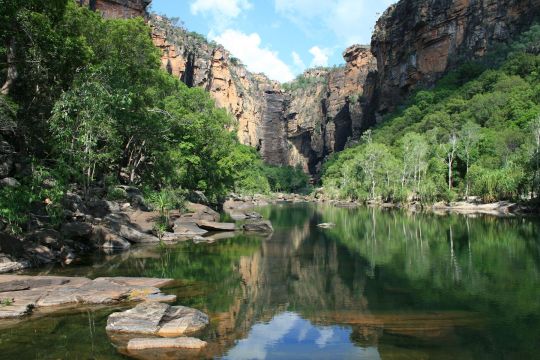
Kakadu's wetlands are a wonder of nature. From the waterfalls to the wetlands, there is something for everyone.
There are many experience tours in Kakadu you can go on that will help you learn more about this beautiful place and its wildlife. If you've ever wanted to visit Kakadu's wetlands, then read on!
Where to start?
Kakadu is a large national park and there are many places to visit. It's best to plan ahead, so you can make the most of your visit.
How do I get there? The closest airport is Darwin, followed by Katherine and Tennant Creek. There are regular flights from Darwin and Katherine into Jabiru, where you can hire a car or bus service for the rest of your journey.
What should I see? Kakadu has something for everyone, whether it's nature trails through ancient rainforests or swimming with crocodiles at one of its many waterfalls!
The Green Tree Frogs of the Kakadu National Park
The green tree frogs of the Kakadu National Park are a common sight in the wetlands and waterfalls. They can also be found in billabongs, which are small pools of water surrounded by vegetation.
The green tree frogs of the Kakadu National Park are small and green, making them hard to see unless you know where to look! If you're lucky enough to spot one, don't worry: they won't hurt you.
Yellow Water Billabong
Yellow Water Billabong is a must-see on your trip to Kakadu. It's a great place to see wildlife, including birds and crocodiles. The billabong is named for the yellow water lilies that grow in the water, which makes it easy to spot from afar.
Yellow Water Billabong is located just north of Kakadu National Park and can be accessed by car or by boat tour with your guide or even by yourself if you're feeling adventurous!
Katherine River
You'll be cruising along the Katherine River, which is the longest river in the Northern Territory. The Katherine River is also a popular destination for canoeing and kayaking, so you'll have plenty of time to enjoy the scenery around you.
If you're interested in fishing or bird-watching while on tours Kakadu, there are many nearby spots that offer these activities as well.
Wangi Falls
Wangi Falls is a great place to swim. The water is safe and clear, but it's also a bit cold, so don't expect to feel like you're on vacation in the Caribbean or anything!
You can swim under one of the falls or jump into one of two pools at the bottom of both falls. If you want something more exciting than just jumping off rocks into water, try swimming downriver from your tour group's boat and back toward them--it'll take some time but will be worth it when everyone sees how brave you were!
Conclusion
Kakadu is one of the most beautiful places on Earth and it's easy to see why. The lush wetlands, waterfalls and incredible wildlife will leave you in awe. If you're looking for tours Kakadu, we’re sure that your travel would be more adventurous.
Source URL: https://sites.google.com/view/tours-kakadu-for-nature-lovers/
0 notes
Video
Untitled by Louise Denton
#koolpin#gorge#kakadu#nt#northern#territory#australia#outback#darwin#jabiru#explore#4wd#hike#travel#light#rock
1 note
·
View note
Text
Kakadu National Park, Kakadu Vacation Travel Guide | Expedia
Kakadu National Park, Kakadu Vacation Travel Guide | Expedia
Kakadu National Park – Step back in time to a wilderness unspoiled by human occupation. Check out the top spots to explore in this remarkable sanctuary.

View On WordPress
#Bowali Visitors Centre#Cooinda#cvg#darwin#Gunlom Falls#Jabiru#Jim Jim Falls#kakadu#kakadu national park#Mamukala Wetlands#Northern Territory (Australian Territory)#Nourlangie Rock#South Alligator River#Twin Falls#Ubirr#Warradjan Cultural Centre#Yellow Water Billabong
0 notes
Text
Kakadu National Park, Kakadu Vacation Travel Guide | Expedia
Kakadu National Park, Kakadu Vacation Travel Guide | Expedia
Kakadu National Park – Step back in time to a wilderness unspoiled by human occupation. Check out the top spots to explore in this remarkable sanctuary.

View On WordPress
#Bowali Visitors Centre#Cooinda#cvg#darwin#Gunlom Falls#Jabiru#Jim Jim Falls#kakadu#kakadu national park#Mamukala Wetlands#Northern Territory (Australian Territory)#Nourlangie Rock#South Alligator River#Twin Falls#Ubirr#Warradjan Cultural Centre#Yellow Water Billabong
0 notes
Text
Lundi 9 mars 2020. Il est environ 4h45 quand nous foulons l'Australie pour la premiere fois. L'avion s'est posé sur le tarmac de Darwin. Nous passons les contrôles des frontières. Toujours la même question : "venez-vous de Chine ?". Un chien policier nous renifle. Pas d'odeurs douteuses. C'est notre sauf-conduit. Rien à déclarer, sauf le bonheur. Nous troquons notre petite voiture pour une plus grosse, sur les conseils du loueur. Bien joué ! La route jusque Jabiru s'est soudainement trouvée submergée par des torrents d'eau. Cela n'a pas l'air de gêner les nombreux wallaroos que nous croisons sur la route. Jabiru est très (très) calme en cette saison humide. Il ne faut pas se baigner nous explique t on, les crocodiles sont nombreux par ici... Ok, on s'abstiendra...




1 note
·
View note
Text
Once a jolly swagman camped by a billabong....
After dropping the Chrises at Sydney Departures to catch their flight back to the UK (see previous blog post for part 1!), I headed onwards to the Domestic terminal to catch a flight up to Darwin. Arriving at 1am, I had a rather sleepless few hours on the floor of Darwin airport before greeting my parents through arrivals at 5am! We had 3 weeks of Outback adventures ahead to catch up on all we’d missed from a year apart!
We picked up our Britz campervan for the first part of the trip and headed straight in the direction of Kakadu National Park on the red dirt roads in the very hot sunshine to get straight into holiday mode! The evening was spent at an old aboriginal site called Ubirr; here there were ancient ochre paintings, beautiful rock formations and stunning vistas, perfect for a sunset viewing!
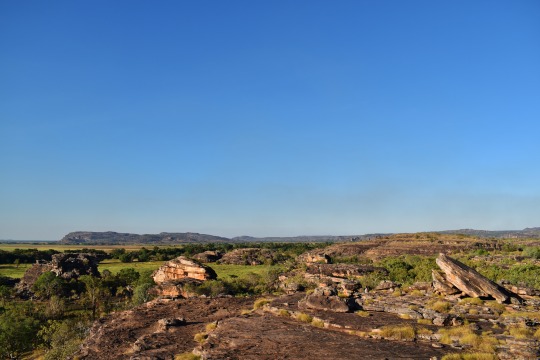
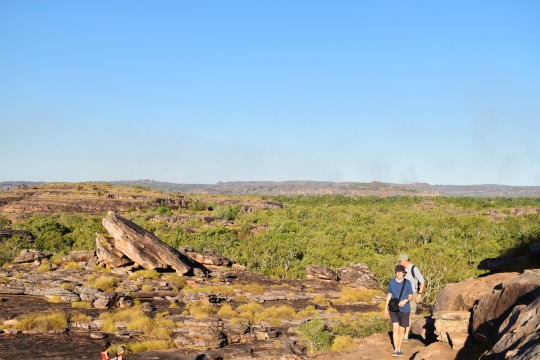
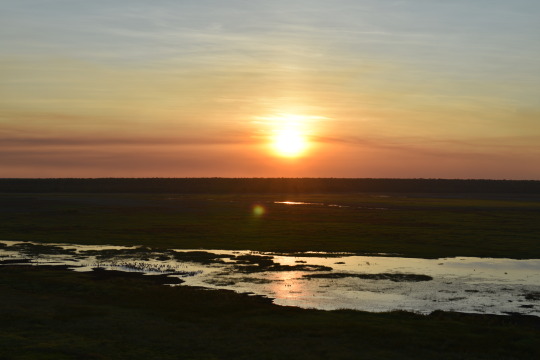
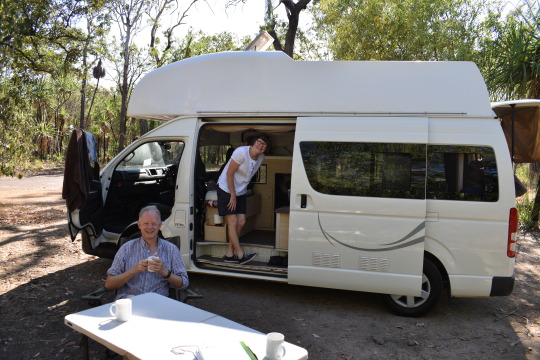
We’d heard there might be a possibility of seeing crocs in Kakadu although none of us were convinced we actually would. However, a stroll to Cahill’s Crossing proved us all wrong; on arrival we could see the ominous backs of about 12 crocodiles swimming around in the inaccurately named ‘East Alligator River’. There were locals fishing in the river standing scarily close to the edge, given that behind them were multiple collections of flowers and crosses commemorating people who had been killed in recent years by getting just that bit too close! It was incredible to see the crocodiles climbing out of the water and watching their size triple from what it had appeared in the water!

All those black dots in the water? Crocodiles!

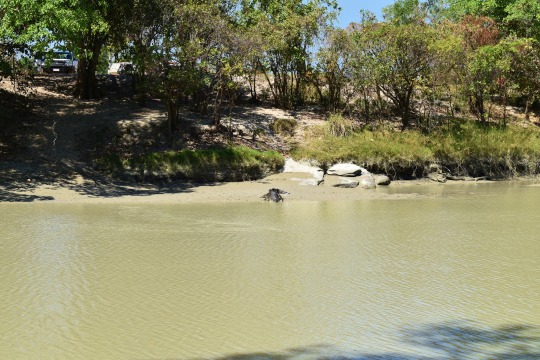
A stunning walk around Bardedjilidgi sandstone outcrops and a steep hike up to Nawlandja lookout overlooking the Nourlangie escarpment provided some of our first exposures to the incredible Kakadu landscape! Given how much land was burning all the time (at one point there were embers right up to the road we were driving along), we were surprised at how green the landscape was.
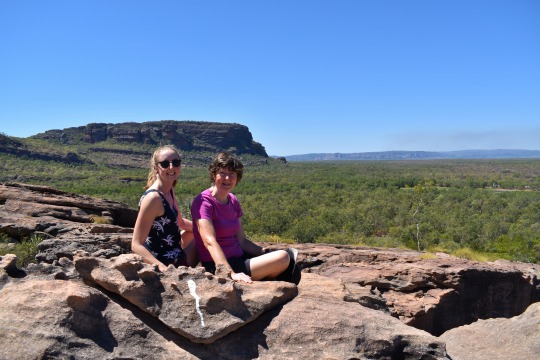
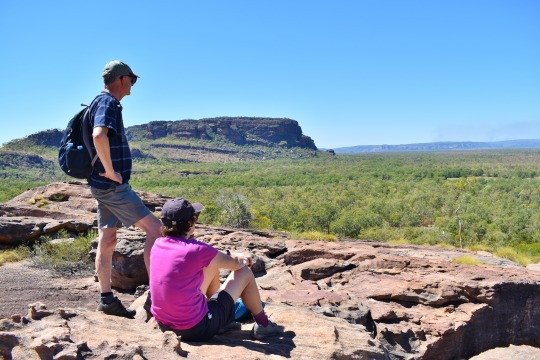

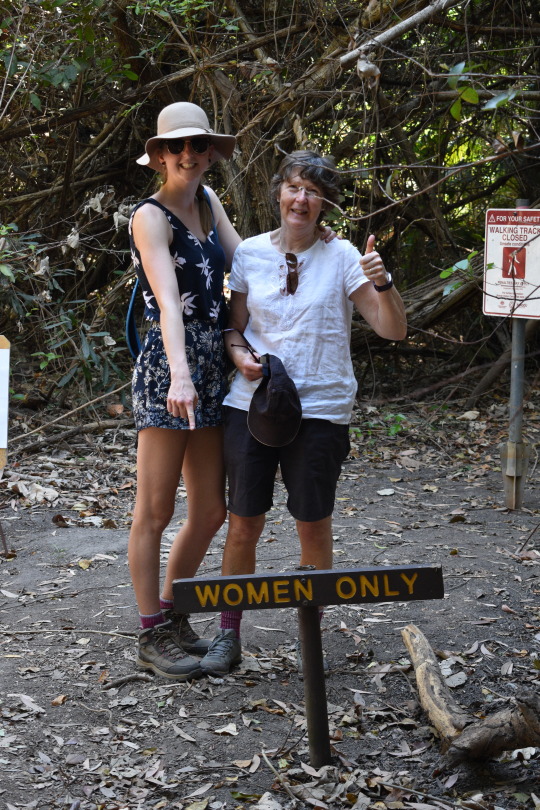
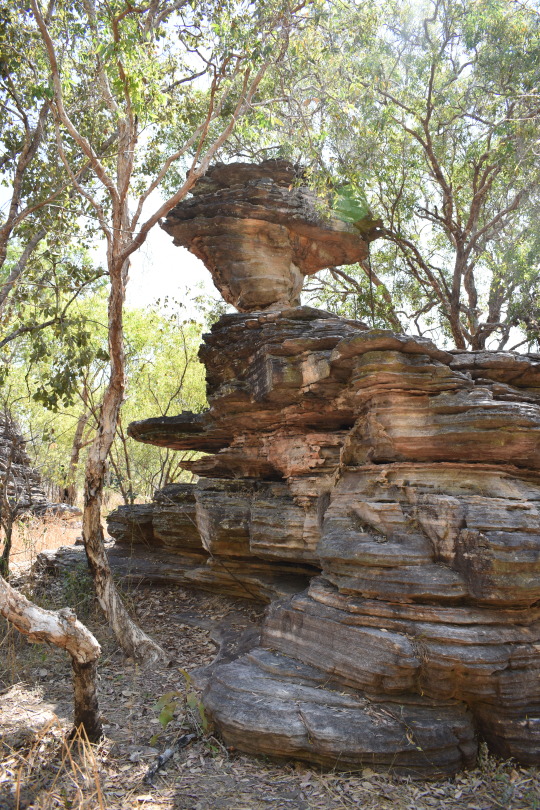
We braved another close croc encounter on a walk around Anbangbang billabong and also spotted our first Jabiru! It looked absolutely enormous – especially in comparison to all the other birds on the billabong!

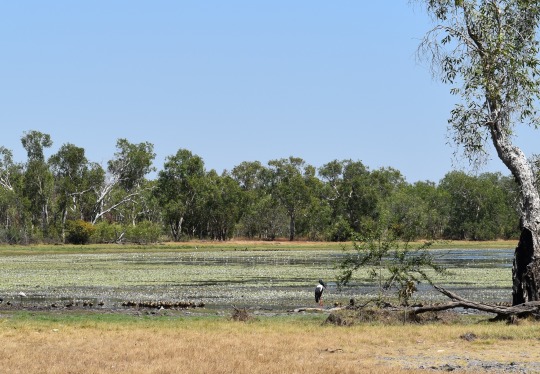
Spent the night at an unexpectedly beautiful campsite on the Mary River where we were surrounded by wallabies and kangaroos!
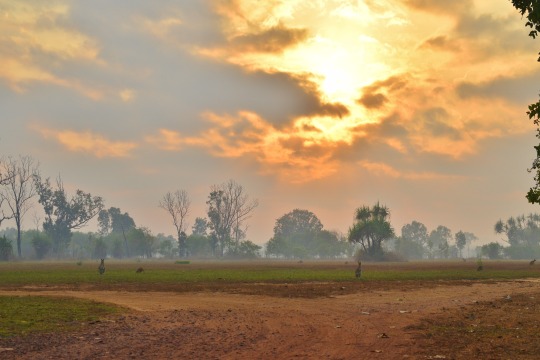

It was time to head across to Litchfield National Park – a smaller area and surprisingly quite different landscape to Kakadu given its relative proximity. We stopped off en route at the ‘magnetic termite mounds’ – so called as they are aligned with their main axis running north to south and orientated such to minimise midday sun exposure and warmth inside the mound. There were also some enormous mounds- up to 5 metres high!
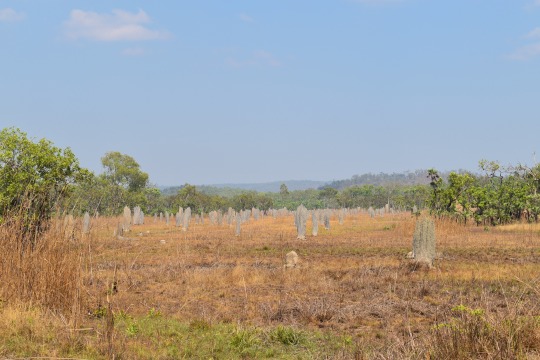
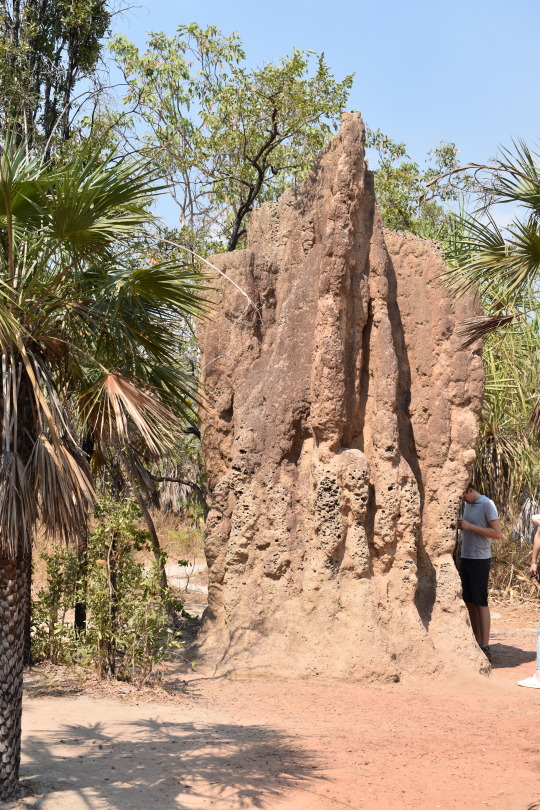
We did a walk to Buley rockholes (which themselves were full of people swimming) but we found our own private one just a few minutes downstream to have a much-needed refreshing dip! Our walk took us down to the popular Florence Falls, and then onwards to the stunning Wangi Falls where we were staying the night! Wangi falls had been closed until the week prior due to crocodile sightings so it was safe to say my mum did not look one bit relaxed for the beautiful sunset swim in there!
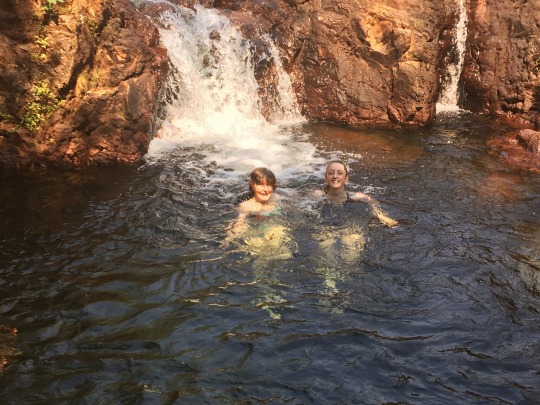
Buley Rockholes
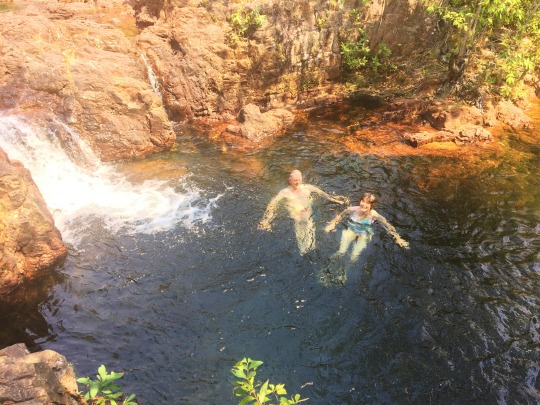

Wangi Falls
We squeezed as many hikes as we could in our short time in Litchfield so our last full day there was spent hiking along the Upper and Lower Cascades (literally clambering down a waterfall). It was so hot and we found an inviting rockhole mid-hike but had left our swimmers in the van– my dad and I are not ones to miss out on a plunge pool swimming opportunity so we just jumped in in our clothes! Lunch was at the top of yet another waterfall amid the Tjaetaba walk through a sharp contrast of monsoon forest and savanna landscapes! We finished the day with a walk around the Tolmer falls which were worth our close shave with heat stroke in the high temperatures of the afternoon!
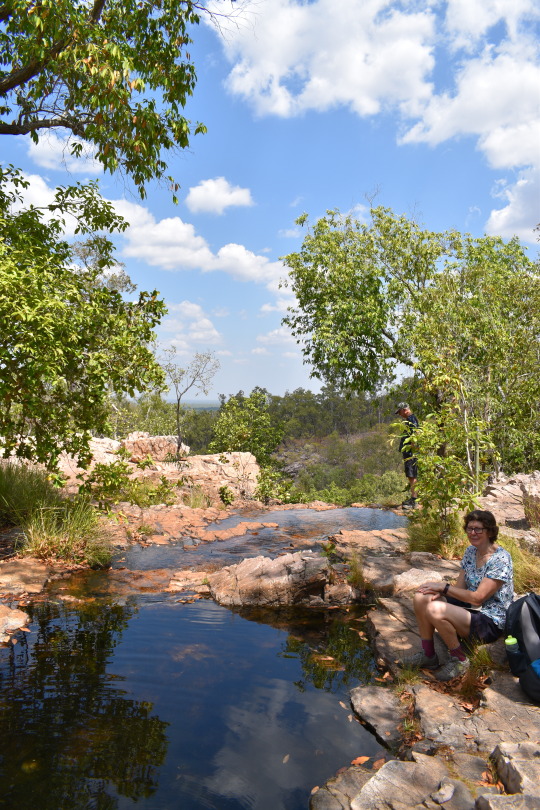

We briefly explored Darwin town centre and harbour before driving to the airport for our flight to Alice Springs for our Red Centre adventure!
Flying in we could see no evidence of any human life anywhere close until we got off the plane and saw there was in fact an airport there! It had just been expanses of red dirt as far as the eye could see, with no town in sight! We were staying in an amazing ‘glamping hut’ I found on Airbnb called Under The Hump. Sitting outside by the firepit having our kanga steaks with a beautiful view of the stars will certainly be one of me lasting memories of Alice! We weren’t quite prepared for the cold weather we would be faced with though – going from 32 degree mornings to 3 degrees was a bit of a shock to the system!
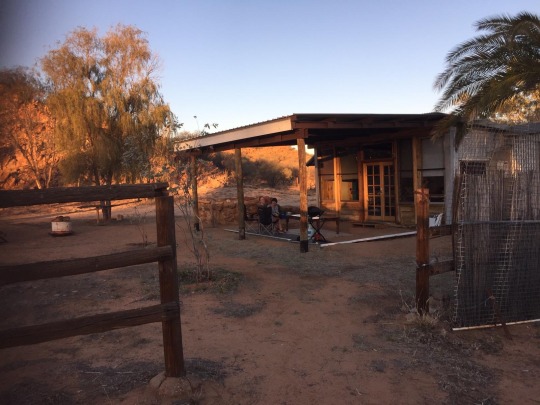
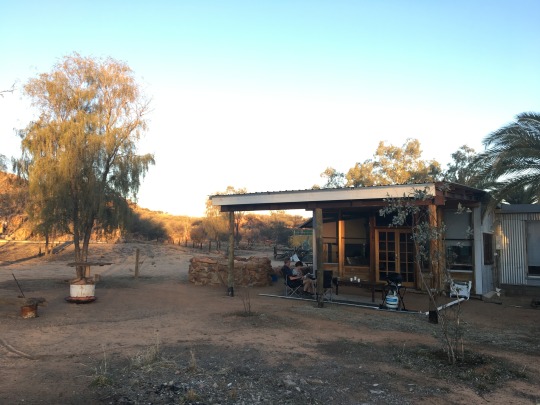
We explored the town and rather fell in love with its character! A small sleepy town surrounded thousands of miles of desert! Having lived by the coast all our life we realised it was the furthest any of us had ever been from the sea!
We explored the famous Todd Mall markets, and went to the Todd River (I was hugely disappointed by this as was expecting an actual river and was met by an expanse of sand. Apparently I was the only one to not be aware that this would be the case. My Tripadvisor review would be a generous 1star as far as rivers go. Same goes for the actual Alice Spring which I didn’t realise we had even seen until I was told later – because it was again just sand.) We spent a fascinating few hours at the National Women’s Pioneer Museum at the old gaol and a visit to the Telegraph station which allowed telegraphs to be sent between Adelaide and Darwin and was the site of the first European settlement in Central Australia (I imagine the Spring actually had water in it at that time….) – although should be acknowledged that the Arrernte people have inhabited what is now Alice Springs for thousands of years prior!

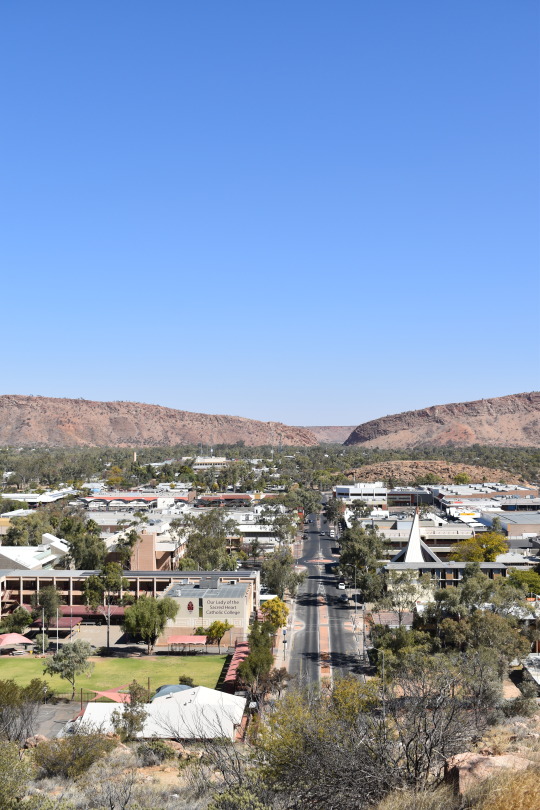
One of my favourite days of the trip was exploring the absolutely breath-takingly beautiful West MacDonnell ranges along the Larapinta trail. We started about 2 hours from Alice at our furthest point, Glen Helen Gorge. It was a deceivingly cold day despite the basking sunshine so we passed on taking the ‘refreshing dip’ here and felt for the many people we saw running who were doing a 4 day Larapinta trail run!

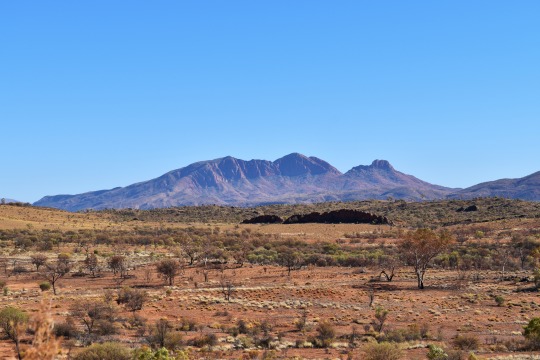
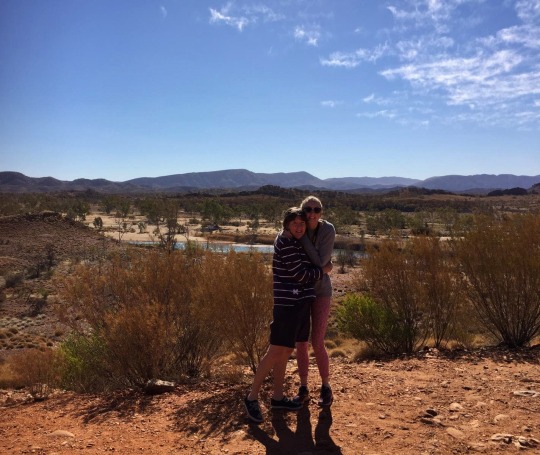
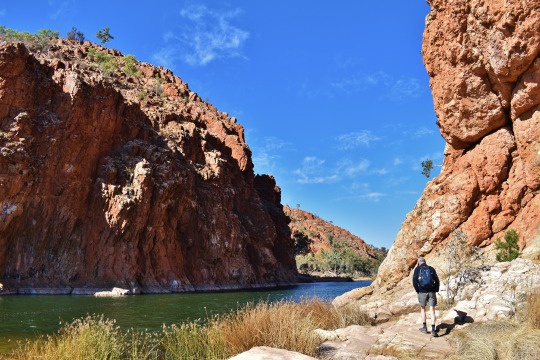
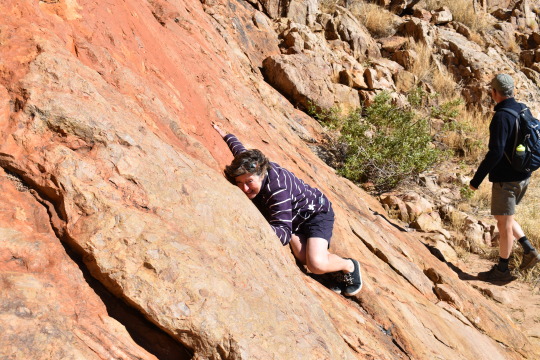
Mum trying to protect herself from the cold wind!
The next stop was the stunning Ormiston Gorge with hike around the top and through the middle of the gorge (which again had no water because dry season!). The other stops along the way are probably best described with photos rather than words. They included the Ochre pits where indigenous people collected ochre to use for rock and body paintings, which they used to tell Dreamtime stories and in ceremony; Serpentine Gorge with a steep hike up to a lookout over the West MacDonnells; Ellery Creek Hole and Simpsons Gap. We had hoped to see a few rock wallabies along the way but unfortunately they may have been hiding away from the cold!
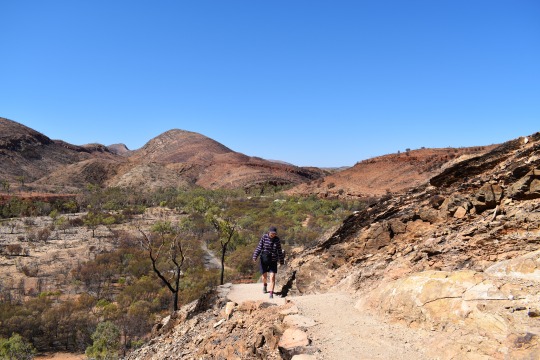


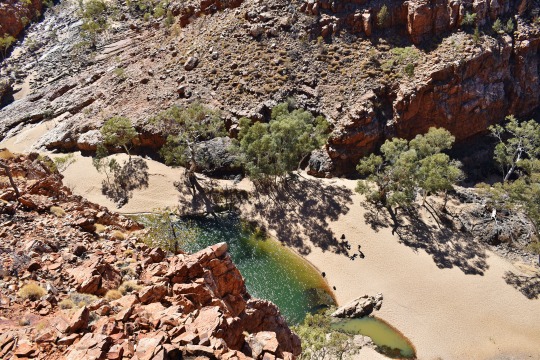
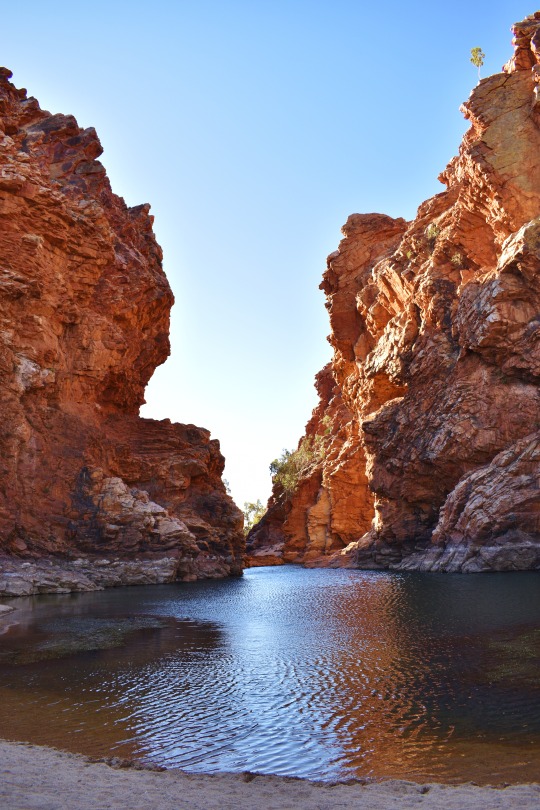
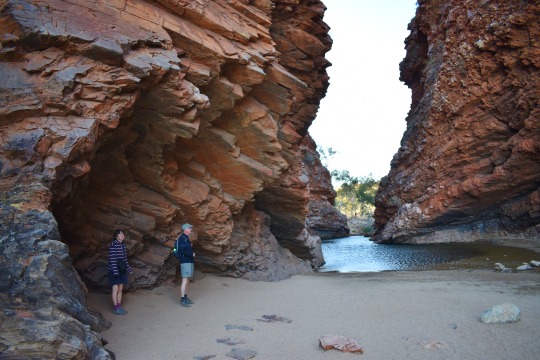

It was a long 5 hour drive down to Yulara (the small resort town for Uluru). 5 hours along a straight road with fairly barren red dirt desert either side; even just this relatively short distance made us appreciate how enormous and sparse this country is. We caught our first glimpse of Uluru and Kata Tjuta from afar as we approached and what a beautiful sight it was! We found a viewing area next to our accommodation where we watched our first of many Uluru sunsets!
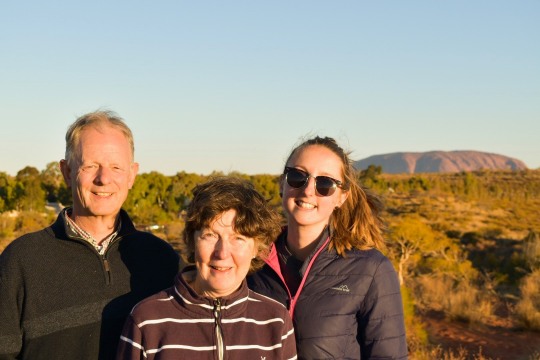
We spent the next 3 days exploring the National Park, learning about the significance of Uluru to the Anangu people and all about the local culture and traditions. Seeing Uluru up close was much more impressive than I'd imagined; what looks like a fairly uniform rock from far away is made of up so many caves and gorges and rock formations which all have cultural significance and stories behind them!

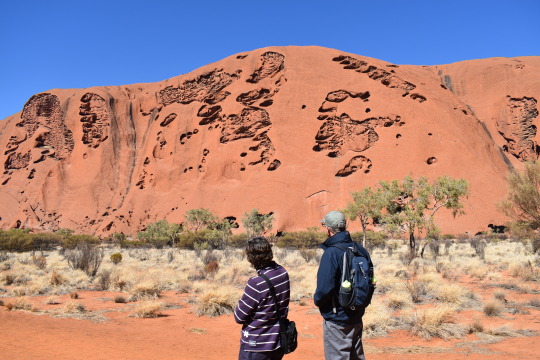
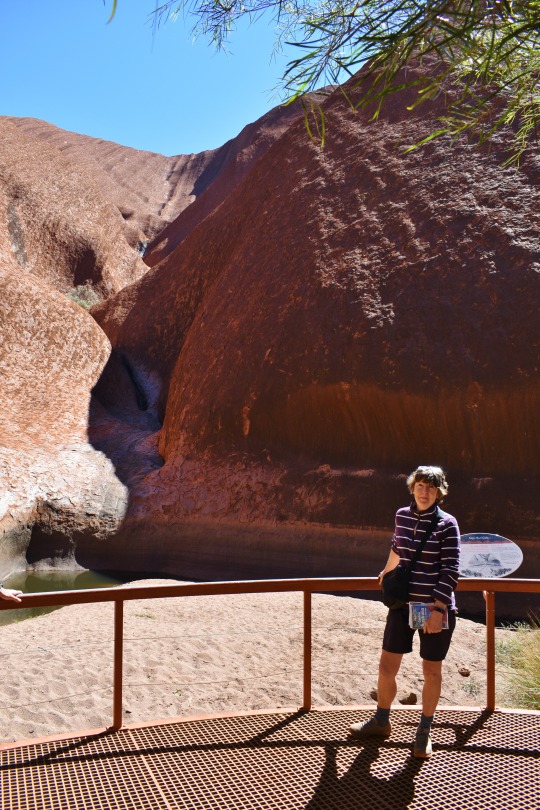
Mutitjulu Waterhole
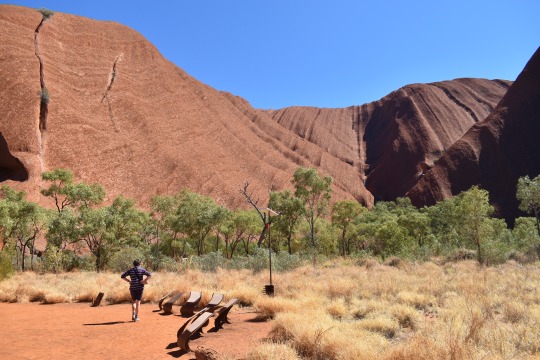
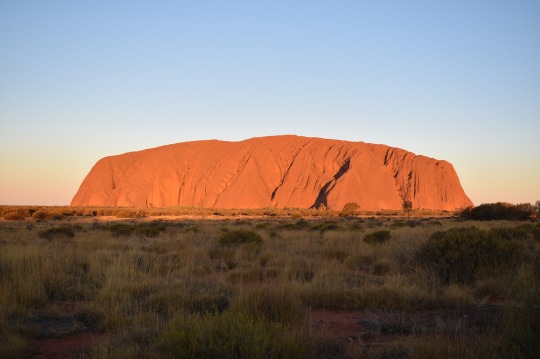
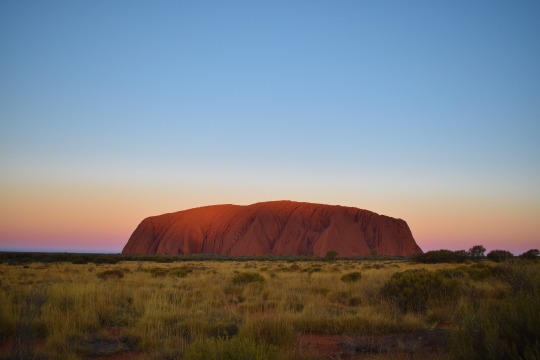
The other place of significance in the National Park is Kata Tjuta (the Olgas) which is a contrasting collection of rocks (the formation of both Uluru and Kata Tjuta seems to be still very much undecided so I’m struggling to know what to call them!). We did an absolutely stunning hike there called the Valley of the Winds with some breathtaking viewpoints.
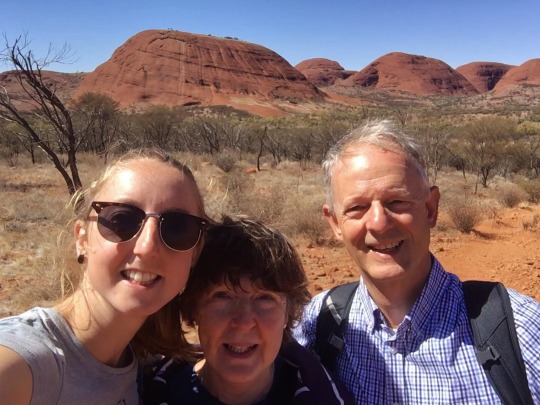
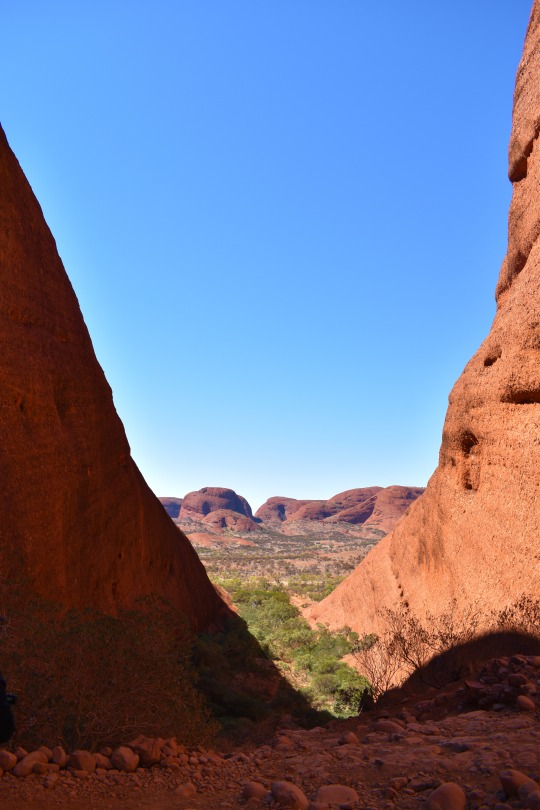
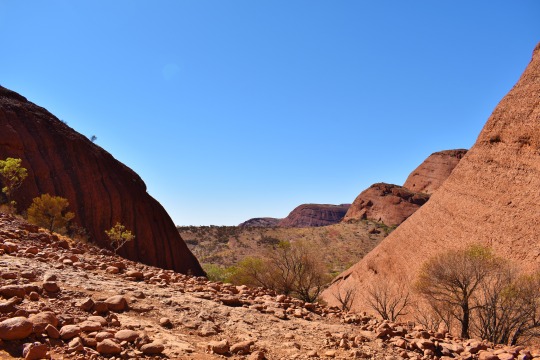
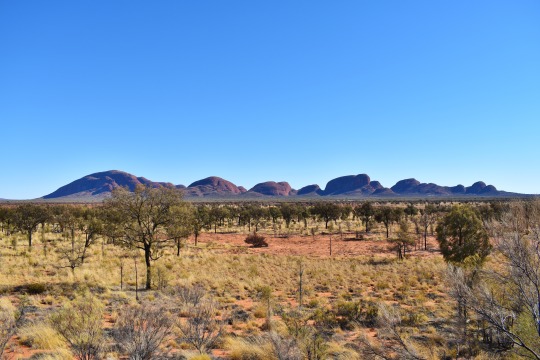


After lots of beautiful sunset viewings, we braved a very early start, armed with a thermos of hot tea, to drive into the Park to watch the sunrise. It was certainly a popular event but we could see why – watching the colours change over Uluru with Kata Tjuta in the distance was just spectacular!
Our legs were exhausted from a lot of hiking so we spent our last day going to workshops and talks put on by the resort, learning about bush tucker, aboriginal hunting tools and even a didgeridoo lesson!
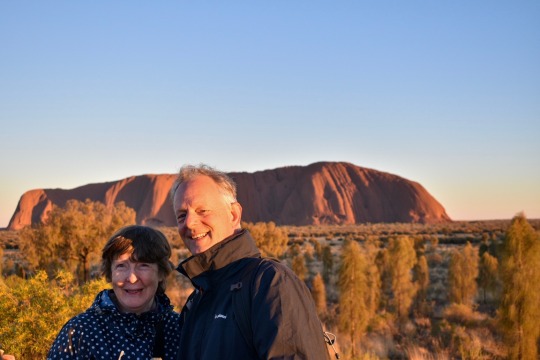


It was time to fly back to Newcastle but what a trip of a lifetime we’d been lucky to experience! It was great to finally show my mum around the place I’ve talked so much about over the past 5 years and to take her back to Sydney to see where they both lived 31 years ago, and meet up with some of their old friends!
Sadly, their life back in England called, so it was another goodbye but we parted ways with so many incredible memories to last a lifetime!
It was back to hospital life and the revision grind for me....
2 notes
·
View notes
Text
One time while in Top End near Kakadu, I was standing on a bridge watching a bunch of 2-to-4-meter saltwater crocodiles chilling in the mud on a river bank. A huge adult “jabiru” (black-necked stork) came swooping in, landed near the wallowing crocs, and started boldly sauntering towards the reptiles. Most of the smaller crocs immediately flinched and moved away from the stork, allowing the bird a corridor to walk down to the river. (Insert reference to parting of the Red Sea.) Some local from Darwin was standing nearby and claimed that this was not all that uncommon. I know that there are folk tales of how saltwater crocodiles fear only one other Australian animal - the jabiru - and I’ve heard this from separate people in both Top End and Queensland, but I’m not sure about the legitimacy of that claim? (After searching “crocodiles” and “Kakadu” for a few minutes today, I typed “can ...” into the search-bar and the first suggested search is “can a jabiru kill a crocodile.”)
Anyway, came across this official statistic from Parks Australia this week:

These are the kinds of headlines I like to see.
2 notes
·
View notes
Video
#Approved#kakadu#flight#helicopter#aerial#stone#country#outback#nt#northern#territory#jabiru#darwin#tourism#travel#explore#flickr
1 note
·
View note
Text
100 day update.
I never planned to go to Australia. Of course, at some point I decided that I would come to live here and had to start working towards it. But to be honest, I can’t remember a distinct moment when I thought to myself “Yeah, I definitely want to go to Australia”. I grew up obsessed with Steve Irwin, who fostered my love for animals, and all things that seemed to push the border of normal. Maybe it was something that had been manifesting in me since childhood. Whatever the reason was, I left home knowing next to nothing about the country I was headed to. I knew the names and locations of a few capital cities, and that it was home to some of the world’s most deadly animals, but that was it. Suddenly one day I found myself at the airport saying goodbye to my parents with my backpack, and that was it. I was on a plane, and I had no idea where I was going or what I was getting myself into. I was absolutely terrified, but I couldn’t wait.
Maui was incredible. It was a dream holiday, and exactly what I needed after 70 hour/ 6 day work weeks. Yoga in the mornings, beach hopping, sunbathing, day drinking, jungle trekking, waterfall climbing, snorkeling with sea turtles, and partying the night away with new friends from around the world; it was the perfect “welcome back” to the backpacker hostel lifestyle I had missed. Breathtaking landscapes, friendly hostel mates, delicious food, long days, late nights, and the slow-paced island lifestyle was the cocktail I needed to kick off my working holiday. It was one of those destinations that make you want to freeze time and stay forever. Eventually though I woke me up from my island dream after managing to lose my wallet (the day before moving overseas!? No worries!).I spent most of my last day on Maui on the phone waiting on hold with my bank, eventually my roommate managed to coerce me into an afternoon beach hopping break to relieve me from the stress. I laid on the shore of Makena beach while I reminded myself of Bob Marley (and my Dad’s) words “Every little thing is gonna be alright…”
Sleeping in airport terminals isn’t the most glamorous part of traveling, nor is it my favorite, but it’s something that I’m no longer a stranger to. I had an overnight layover in Honolulu, where the airport welcomes stranded travelers with a designated area to sleep in. While the benches didn’t make the most comfortable bed I’ve ever slept on, I was able to catch a few hours of good rest. In the morning I woke to a beautiful sunrise bidding me a final goodbye from the states, and after the longest walk of my entire life to the other side of the world in the terminal, and a goodbye call to home I boarded my plane. A window seat in econcomy on a budget airline promised me that a year of adventure laid just a sore neck and a close of my eyes ahead.
The day I arrived in Sydney I felt pretty overwhelmed. I had just moved to the other side of the world, and since I’d lost my wallet, I only had the bit of cash I had brought with me. I was feeling pretty grateful for an exchange rate that worked in my favor, a hostel kitchen with 8 (eight!!!!) stoves, and a clean bed to relax in after the journey over. My first priority was to get my money sorted; it didn’t take long for the Sydney sticker shock to set in and I knew I needed to work it out. I was up with the sun my first morning to head to the bank where I learned two things: 1. It gets cold in Sydney (who knew that Australia actually has a winter too?!) 2: It would be over a week before I could get access to my money Deep breaths, everything is going be alright. Stressing out about it wasn’t going to get me anywhere. I’ve got this; I’ve done the whole hungry budget backpacker thing before. No worries.
In the midst of work/life chaos before leaving home, I had decided to book my first week in Sydney with a tour company. This was my first time doing organized travel and although it lacked a little freedom, I was glad that I had decided on it. They had set up my accommodation for the week and a few meals, so I didn’t have to worry about spending too much until I could get my card. I was grouped with some lovely and hilarious English and Canadians who were also starting out on their working holiday visas. It was comforting to be around people who were in the same boat as me, but it also was a bit strange to be at the mercy of whatever was planned for us. 6 days and 5 nights in Sydney and Port Stephens: complete of course with the obligatory city walking tour and pub crawls. It was an interesting change of pace from the travel that I’m used to. No planning on my part, just “Show up here at this time and we’ll take care of everything for you”. A harbor cruise and boat barbecue, an evening exploring the dazzling VIVID Sydney displays, yoga with kangaroos at an eco-hostel, a hike through Tomaree National Park, boarding through sand dunes, restaurants with food that looks like it came straight out of one of those trendy facebook videos, drinking games, nights out dancing, and a sales pitch just every now and then to gently remind you that your tour leader was getting paid to hang out with you. While it was fun to have my days filled with things that I probably wouldn’t have done on my own, I was desperate for a little independence which I was able to find at a couchsurfing meet-up.
I fell in love with couchsurfing while I was in Ireland a year ago. I was in Dublin, my first big city on my solo Europe trip and I joined a meet up for a hike on the coast of Howth, a fishing village an hour bus ride outside of the city. After our walk through the cold wind and rain, we took refuge at a jazz and blues festival pub crawl. Hours went by chatting to each other and listening to music before heading back into the city together. I had never met so many people from so many different places, and being new to traveling it blew my mind to feel so welcomed by everyone; I knew that I would definitely be doing it again. Shortly after I had gotten home from Europe I started attending meet up every week in Phoenix. I haven’t surfed yet, but I definitely plan to soon. When I got to the bar in Sydney, I was greeted by friendly faces, and after watching fireworks over Darling Harbor, I was invited to head to someone’s flat for pre-drinks followed by a Friday night out. I didn’t need much convincing, but the promise of free drinks and new friends made any hesitations I might have had disappear.
After a week in Sydney, I was ready to move on. My bank was going to forward my card to me, so all that was left to do was set up my phone plan, book my flight, and then I was ready to head out on the next chapter of my journey. After a bus ride, a flight, another flight, a bus, a few hours of sleep, and another bus, I arrived at my new home away from home. The Northern Territory: home of crocodiles, and barra fishing; where winter is a sunny 40 degrees Celsius, and men brag about the size of their fish. I would be spending the next 88 days working remotely in Kakadu National Park. Remote work is required by Australian Immigration to extend your Working Holiday visa from 1 year to 2 years. Where and what you can do depends on which visa you are on. But for me, this meant administration work at a hotel.
My bus left from Darwin at 6:30 in the morning, and after a 3.5 hour ride through the middle of nowhere, the bus pulled over and it was my turn to get out. It felt like a scene from a movie, getting off the bus with my backpack, walking through the doors of this little green hotel in the desert. Things moved pretty quickly as soon as I arrived and I started work the next day. It took a few days to get situated, but everyone I worked with were backpackers, so it didn’t feel too unfamiliar. What did take some getting used to was the isolation.
Kakadu National Park is more than half the size of Switzerland, and with a population totaling just 1130 people, it’s easy to feel small in such a big space. The hotel is a half hour drive from Jabiru, the only town in the park, which boasts a shopping center featuring a small grocery market, library, bank, police station, hairdresser, and an Olympic sized swimming pool (to which I regularly wonder how on earth they managed that). It’s pretty much impossible to get anywhere around the park if you don’t have a car without hitchhiking, however I managed to make it away from the hotel quite a few times in my first month. My first trip was to Yellow Water Billabong. We spent the afternoon on a river cruise learning about some the Aborignal history in the park and the unique wildlife, bird watching, looking for buffaloes, and of course, spotting crocs. A few days later we were off to Ubirr, the largest rock art site in Australia. On our way, we stopped at Cahills Crossing, the border to Arnhem land, where the aboriginal community live. At high tide when the river flows over the crossing, you can be eaten alive by mosquitoes while watch crocodiles at the edge of the water, waiting for fish to be pushed into their mouths. After finishing the climb to the top of Ubirr, you are welcomed by a 360 degree view of the park. Being there felt like I had been taken back to the Jurassic age. Looking out across the wetlands, I half expected to see a dinosaur, or lions and elephants walk across the plains. During this time of year, Wurrgeng season, the locals burn the land to prevent bush fires and help restore nutrients to the soil. The smoke from the controlled burns turns the sky beautiful colors, and the sun a deep glowing red. It’s a picture that each time I’ve visited reminds me of the opening scene from The Lion King.
Remote living is a unique experience. You work, sleep, eat, live, and play all in the same place with the same people. Imagine laying out in your backyard at the pool with a book on your afternoon off, then your manager walks through your back gate to let you know that the schedule has changed and now you need to be back in the office to close in half an hour. It’s your day off and you’re having a late breakfast in your kitchen in your pajamas, and in they come to tell you all of the things they would like you to do tomorrow. Work-life balance does not exist, they are one and the same. This made the work become frustrating quickly, and management challenging to deal with to say the least. As staff you quickly learn to rely on each other: celebrating small victories together, acting as an outlet for frustration, and taking a little extra time and effort to do things as a group. I found the answers to “what will I do tonight?” were different than they had ever been. Taking dinner out to the grass for a picnic instead of eating in the kitchen, grabbing a beer and going for a walk to the billabong at the back of the hotel, being workout buddies at the gym, drinking until late (which now meant 10pm) doing puzzles, playing and billiards in the rec room, or playing cards sprawled across the floor of your hotel room.
Of course my favorite days were my days off. While there were certainly hardships to living in the middle of nowhere without my own mode of transportation, it was the first chance I’d had in a long time to learn how to live life slowly. I no longer had to wake up early on my day off to make it to Bikram Yoga, or run to the grocery store and spend hours cooking in the kitchen (although I do miss those things dearly now). I could be lazy ,and not feel bad about it! I could sleep until my body decided it was time to get up, head to the gym when I felt like it, float in the pool for hours, listen to a podcast during a walk through the forest, read a book in my hammock, practice yoga at the gym, and still have hours left in the day to burn (my hula hoop, of course). And on the days when I felt like I had cabin fever coming on, I had the entirety of the park at my doorstep. A spur of the moment decision and catching the boss in a good mood meant you could ask for the keys to the company car. Maybe having an early afternoon off meant going for a drive to the Mamukala Billabong for some birdwatching, over to Burrunkguy to admire more rock art, and then to Nawurlandja to watch the sunset. On one of my lucky days I had the day off with someone with a car and we took the 3 hour drive through the park to Gunlom Falls. A 25 minute hike up a steep cliff led us to breathtaking views at the top of the waterfall (and with crocodiles being one of the most populous residents of Kakadu) meant one of the rare chances to swim in the infinity pools. One day after catching a late bus and being temporarily stranded, I even worked up the courage to try hitchhiking. It was a rough go at first, but after half a bottle of sunscreen I got picked up by a fisherman that took me to the South Alligator river. We cast a line out together and watched crocodiles swim by before taking me back to the hotel.
As backpackers, this was only our temporary home, and we all had another adventure planned when our 88 days came to an end. The nights before we said good bye were always my favorite: both fun and bittersweet. The bonds that formed over such close quarters always hurt a bit to sever, but it was impossible not to be excited for them to continue on their own journey.
One of the biggest things I have learned from traveling is to let go of my expectations. I didn’t really know what it would be like or what would happen living here, but I can say easily that most of this had never crossed my mind. The past 100 days have been a roller coaster ride of emotions and adventure, and as I enter my last week at Aurora Kakadu, I can’t contain my excitement for the future. I’m so grateful to all the people I have met along the way. What an incredible opportunity, to live in such a uniquely beautiful place (I mean come on, how many people can say that they’ve lived in a National Park that’s a dual listed UNESCO World Heritage site?!). It’s offered a unique glimpse into Aboriginal culture, and it has been a once in a lifetime experience that I will never forget. I’m looking forward to getting back on that bus in a few days and taking all the lessons that I’ve learned with me on my way. In 8 days I will be on a plane on my way to Queensland (home to the zoo of my childhood hero) to explore The Daintree Rainforest, and The Great Barrier Reef.
100 days down since leaving home, 269 days left in Australia, and then…. We’ll see.
11 notes
·
View notes
Photo

Outback Towing offers skilled and affordable towing services in and across Darwin, NT. If you have been in an accident or if your car has broken down and has to be towed, our well-trained team is here to assist you.
We provide excellent services and respond quickly. While your vehicle is being towed, we take the utmost care of it. We do everything from car towing and off-road recovery to picking up and removing old unregistered and unwanted cars, 24 hour emergency accident towing, 24 hour breakdown towing, vehicle transport services, motorcycle towing, equipment transport services, low & prestige vehicle stowing, and 4 x 4 car recovery.
Our service regions include Coconut Grove, Jabiru, Katherine, Maningrida, Adelaide River, Darwin, and nearby suburbs.
Location:
4 Tang Street, Coconut Grove Northern Territory 0810, Australia
Business Hours:
Open 24 hours
Contact Us:
0432 642 829
1 note
·
View note
Text
Choosing The Right Guided Tour For Your Kakadu Adventure

Choosing the right guided tours of Kakadu can be a big decision. The right one will help you make the most of your time in Kakadu National Park and get you closest to nature without having to deal with all the hassle of planning a trip yourself.
What are the most popular Kakadu tours?
The most popular tours are the 4WD and boat tours. The destinations are Nitmiluk National Park and Nourlangie Rock, which offer swimming, hiking, and fishing opportunities.
Of course there are many other options for you to choose from in Kakadu National Park!
For more information our Visit Website: https://www.inspiringvacations.com/au/kakadu-tours/
Kakadu National Park is located in the Northern Territory of Australia, north of Alice Springs and east of Darwin. The park covers an area of approximately 20,000 square kilometres (7,704 sq mi), making it one of the largest national parks in the world.
The park is well known for its exceptional wildlife and vegetation, as well as for its ancient Aboriginal rock art. Kakadu contains a wide variety of habitats including wetlands, riparian forests, open savannah woodland and grasslands.
Where can I go on my Kakadu tour?
There are many tour options to choose from. You can go on a Kakadu National Park tour or a Nitmiluk National Park tour, which is also called Katherine Gorge. You can also visit Litchfield National Park and Prince Regent National Park.
The best way to decide what type of tour you want is by considering what kind of experience you're looking for and how long you'll be staying in Australia. If this is your first time traveling abroad, then we recommend starting with one of our short trips that only last 3 days or so; these tours will give you an introduction into what it's like to travel internationally while giving your body time adjust before venturing out further into the country (or even continent).
Our most popular option for first-time visitors is our 4-day Kakadu Adventure package--this includes all transportation between destinations as well as lodging at either Kings Canyon Lodge & Resort or Jabiru Gardens Hotel & Spa within Kakadu National Park itself!
What should I expect from a Kakadu tour?
Kakadu is a land of incredible beauty and diversity, with a wealth of wildlife, landscapes and history to explore.
If you're planning on taking a guided tour around Kakadu National Park, here's what to expect:
Weather - The weather in Kakadu can be unpredictable at times; it can change from hot and sunny one minute to rainy and cool the next! Make sure your tour includes rain gear so that you're prepared for any eventuality. It's also important that your tour includes air-conditioned vehicles so that when things get too hot or cold inside them (or both), they have somewhere cool to go where they can rest while waiting out their bad luck streak.
Wildlife - There are many species of animals living within Kakadu National Park including crocodiles, kangaroos and dingoes but also some less common creatures such as snakes or lizards which may not always be visible depending on whether they've been disturbed recently by humans entering their habitat area too closely without being aware what might happen after doing so.
Conclusion
Kakadu is one of the most spectacular places on earth and offers a range of activities for everyone. Whether you're looking for something adventurous or relaxing, we can help you find the right guided tours of Kakadu to suit your needs.
Source Url: https://guidedtourpackages.blogspot.com/2023/05/choosing-right-guided-tour-for-your.html
0 notes
Text
Best Waterfalls in Northern Territory
If you love roadtrips, the northern territory of Australia awaits you with open arms. There are the beautiful streets of Darwin adorning the look of a modern art place which is bustling with restaurants and open roads. You cannot miss the beauty of modern fused in traditional attire, sitting and embracing the moment while in Darwin. If your love for waterfalls is immense, then you should pay a visit to these incredible falls there. You can park your campervan rental Darwin at the car park before proceeding to the falls and taking the walk. 1. Bitter Springs, Katherine It is located at a distance of two kilometers from Mataranka. This springs is part of the Elsey National Park. It is present among the palms and woodlands present in this region. You will notice some thermal pools too present in this part of the land. If you are looking for a place to unwind, this could be your setup. It has all the makeup of the perfect picnic spot. 2. Edith Falls This too is present in Katherine, towards the north. It is located inside the Nitmiluk National Park. If you love walking or trekking, this 62-kilometer stretch is just for you. If you are in for some adrenaline rush or a day’s adventure, nothing stops you from visiting this trail. While you are experiencing your trek, you can also visit the Leliyn Trail which is another excellent experience. The waterfalls in this location are an excellent place for swimming. You can dip in these pools and enjoy some essence of water while your motorhome hire Darwin is parked in the carpark. 3. Florence Falls This is located in the central part of Litchfield National Park. You need to drive to this park from Darwin. It is one of the most scenic falls in this part of Australia. It takes you through a panoramic view of the valley as well as the waterfall. When you reach this part, you will see that it is surrounded by monsoon forests. You can take the shady creek walk or just go for a swim while you are there. The water surrounding this region is crystal clear. 4. Wangi Falls If you want to visit the most attractive waterfall in Litchfield, then you should take a day trip to Wangi falls. You can view this falls from different angles, because every road you take leads to a different part of the falls. the best part about this region is the extremely cared for lawns and gardens. You can actually spend a day leisuring around in this space while your campervan rental Darwin is parked in the parking area. You would love the walk through the rainforest, while breathing in the beauty of the green surrounding you. 5. Jim Jim Falls It is located around 45 kms south of Jabiru. You need to go through a two-hour trail to reach the waterfalls. It is a 200 meter waterfall. It is surrounded by a beach and has several pools too. You should take your motorhome hire Darwin to this place to enjoy a day or two of adventure and beach time.
0 notes
